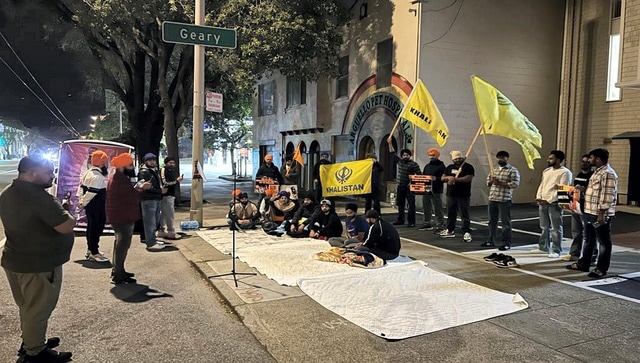After Canada, is pro-Khalistan sentiment growing in the US?
After Canada, is pro-Khalistan sentiment growing in the US?

A Hindu temple in the United States was defaced with pro-Khalistan graffiti on Friday (22 December), prompting the Indian Embassy in San Francisco to seek a probe into the incident. Images shared on social media show the word ‘Khalistan’ sprayed on a signpost outside the SMVS Shri Swaminarayan Mandir in California, while slogans against Prime Minister Narendra Modi were written on the walls of the temple.
The Newark Police said they are investigating the incident as a potential hate crime. “Based on the content of the graffiti it is believed that the defacement was a targeted act, and the vandalism is being investigated as a possible hate crime,” the City of Newark Police Department told news agency PTI in a statement.
This is not the first incident in the US, which has previously seen attacks on Indian consulate’s property by Khalistan supporters. Several instances have also come to the fore from Canada, Australia and the United Kingdom.
Let’s take a look at if the Khalistani sentiment is rising in the US.
India demands action
Speaking to the media about the incident on Saturday (23 December), External Affairs Minister S Jaishankar said he is aware of the defacement.
“Extremists, separatists and such forces should not be given space. Our Consulate there complained to the government and the police and an inquiry is underway,” ANI quoted him as saying.
#WATCH | On Swami Narayan temple in Newark, US defaced with pro-Khalistani slogans, EAM Dr S Jaishankar says, “I have seen it. Extremists, separatists and such forces should not be given space. Our Consulate there complained to the government and the police and an inquiry is… pic.twitter.com/dfEzsfeeT8
— ANI (@ANI) December 23, 2023
Condemning the incident on X, the Consulate General of India in San Francisco said it has “hurt sentiments of the Indian community”. “We have pressed for quick investigation and prompt action against the vandals by the US authorities in this matter,” it wrote in the post.
We strongly condemn the defacing of SMVS Shri Swaminarayan Mandir at Newark, California with anti-India graffiti. This incident has hurt the sentiments of the Indian community. We have pressed for quick investigation and prompt action against the vandals by the US authorities in…
— India in SF (@CGISFO) December 23, 2023
The incident comes nearly a month after the United States Department of Justice charged an Indian national for involvement in an unsuccessful plot to murder Khalistan separatist and Sikhs for Justice (SFJ) founder Gurpatwant Singh Pannun in New York.
Pro-Khalistan incidents in US
In July, Khalistan supporters tried to set India’s consulate in San Francisco ablaze. There was not much damage to the property and the fire was quickly doused by the San Francisco fire department.
Matthew Miller, the spokesperson for the US state department, had said at the time that America “strongly condemns the reported vandalism and attempted arson” against the Indian Consulate in San Francisco. “Vandalism or violence against diplomatic facilities or foreign diplomats in the US is a criminal offence”.
The Indian consulate in San Francisco had come under attack in March as well when a group of pro-Khalistani protesters installed two Khalistani flags inside its premises. The flags were soon taken down by the consulate personnel.
According to PTI, the angry protesters had also barged into the consulate premises and struck the door and windows with the rods they were carrying.

The US incident had come hours after Khalistan supporters pulled down the Indian national flying atop the Indian high commission in London. They were protesting the Punjab Police’s manhunt for Sikh separatist leader Amritpal Singh.
Other countries with sizeable Sikh populations, such as Canada and Australia, had also reported protests against the crackdown on Waris Punjab De chief Singh.
Security had to be ramped up outside the Indian Embassy in Washington DC on 15 August – India’s Independence Day – in view of protests by pro-Khalistani groups.
In March, a group of Khalistan supporters staged a protest in front of the Indian Embassy in Washington DC, threatened Indian Ambassador to the US Taranjit Singh Sandhu, attempting to incite violence. They tried to vandalise the Indian Embassy property but were stopped by law enforcement agencies, reported PTI.
Why is there support for Khalistan abroad?
For years, Khalistan supporters have staged protests against India and even organised so-called referendums on Khalistan in Australia and Canada.
While there are hardly any takers for Khalistan in Punjab today, the demand for a separate Sikh homeland still finds resonance among some members of the Indian diaspora, especially those who do not understand the changed realities of the Indian state.
Journalist and writer Amandeep Sandhu told Scroll that the idea of Khalistan has more backers overseas than in India. “Most Sikhs in India, especially those living outside Punjab, want things to be peaceful. They don’t think of Khalistan and have integrated with other communities and with the mainstream.”
Many Sikhs who left India in the 1980s and the 1990s claimed they were fleeing “oppression”. Sandhu said the Sikh diaspora has “grown up hearing stories about India being unjust to Sikhs. There has also never been justice for the 1984 anti-Sikh Delhi pogrom. This continues to give some of them reasons to believe that India is a regressive state”.
“They have either not seen today’s reality in India or seen it in a limited way. So, they see it from a different psychological perspective,” Scroll quoted him as saying.
However, it is only a “small percentage of the Sikh diaspora” that is calling for Khalistan, according to Sandhu.
Terry Milewski, a Canadian journalist and author of Blood for Blood: Fifty Years of the Global Khalistan Project, told the Indian Express in 2021, that the new generation of Sikhs do not have “much memory” of the 1980s and early 1990s when thousands of people were killed in the Sikh insurgency. He believed the Khalistan movement is “failing” among the diaspora.
“The new generation doesn’t have much memory of all that. So, how long this movement will survive even in the diaspora is a question to be asked. I think it’s failing pretty fast”.
With inputs from agencies







